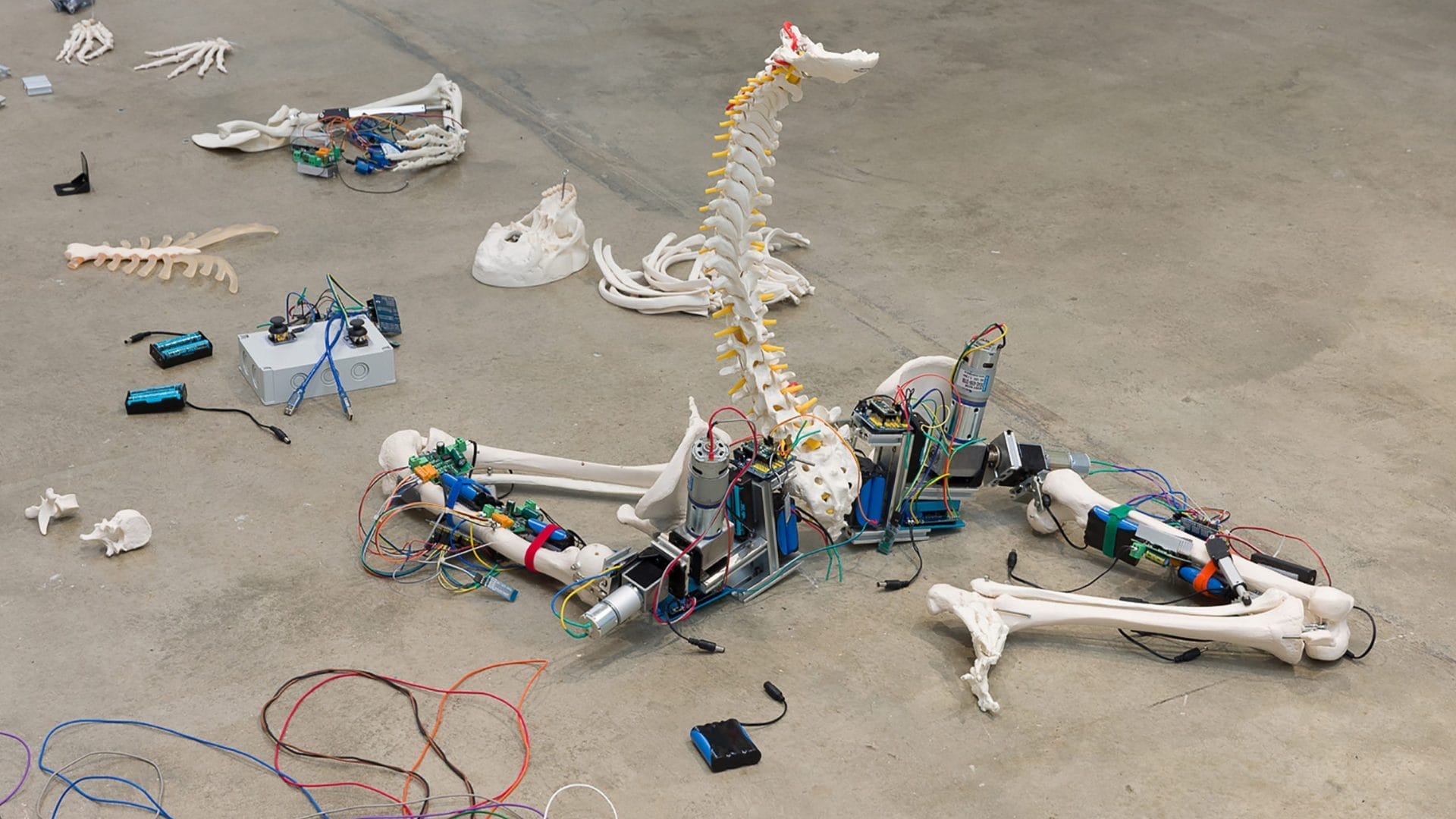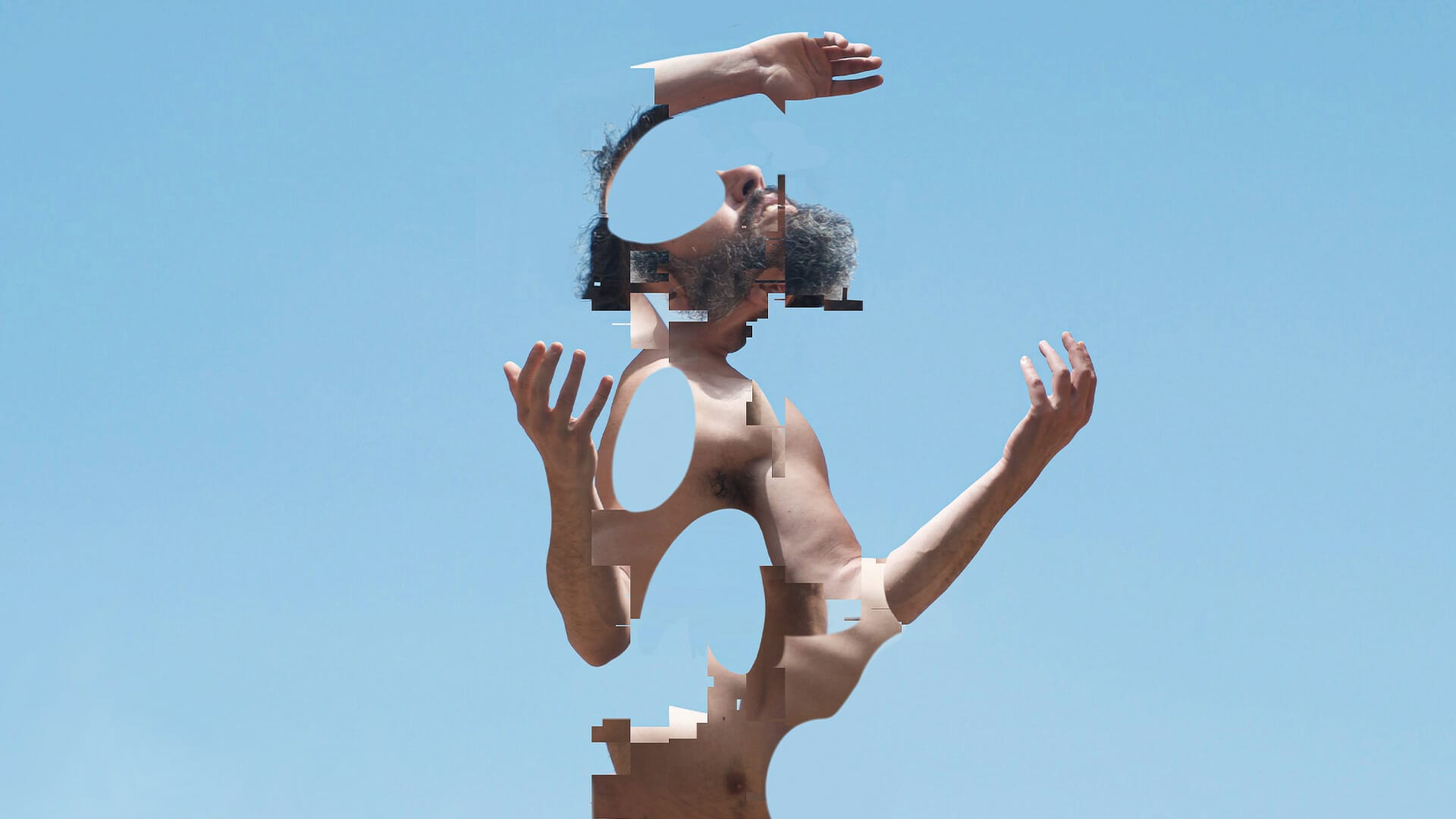
How to craft an art tribe with open source DNA?
Decentralized Dynamics and Protocols: A New Type of Art Manifesto in the Internet 3.0 Era?”
URL frens to IRL friends
I’ve just come back from a unique experience in a chateau, with internet people, from web3, AI, crypto-Art and traditional Art.
Internet culture is an organism in constant mutation, which is not uniform, as it is made up of several “micro-niches” that interact with each other through codes.
These codes are often transmitted through a form of non-verbal language, aesthetics shared realities. Myths. Memes.
Unlike governance in politics, finance, and societal life, aesthetics is not something derived from consensus. Therefore, a significant challenge is to try to discern a pattern that could resemble a shared vision when discussing art and the internet.
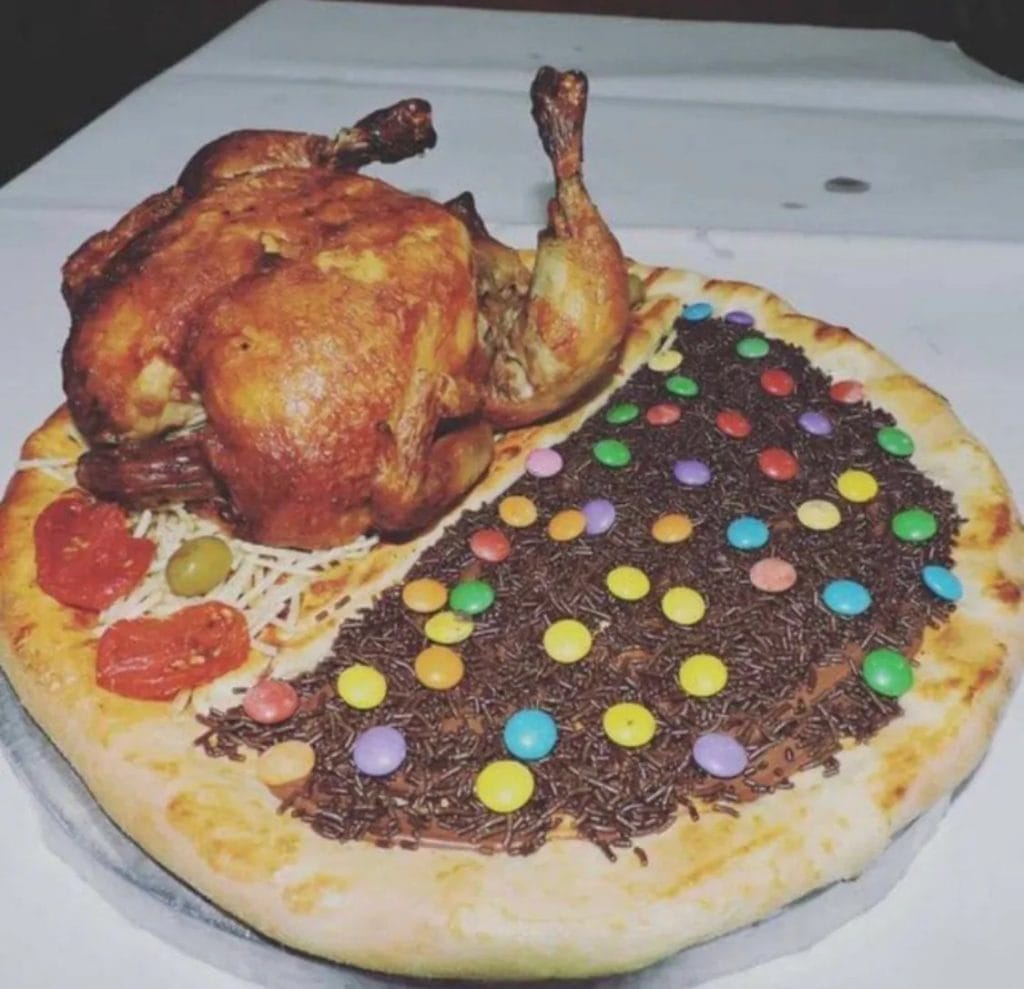
Lost Tribes & Artists 3.0: decoding the canevas
This text, written spontaneously, has the “non-exhaustive” aim of sketching a panel of the different players in these worlds, and proposing a common playground for building something together, as an aesthetic impulse in the open source spirit of the original internet.
The sect of Contemporary Art
For more than a decade, I am involved as an artist in what I affectionately call the “cult” or “sect” of contemporary art. By this, I mean the ecosystem where creators, thinkers, and enthusiasts engage in an artistic discourse rooted in the “official” continuity of art history.
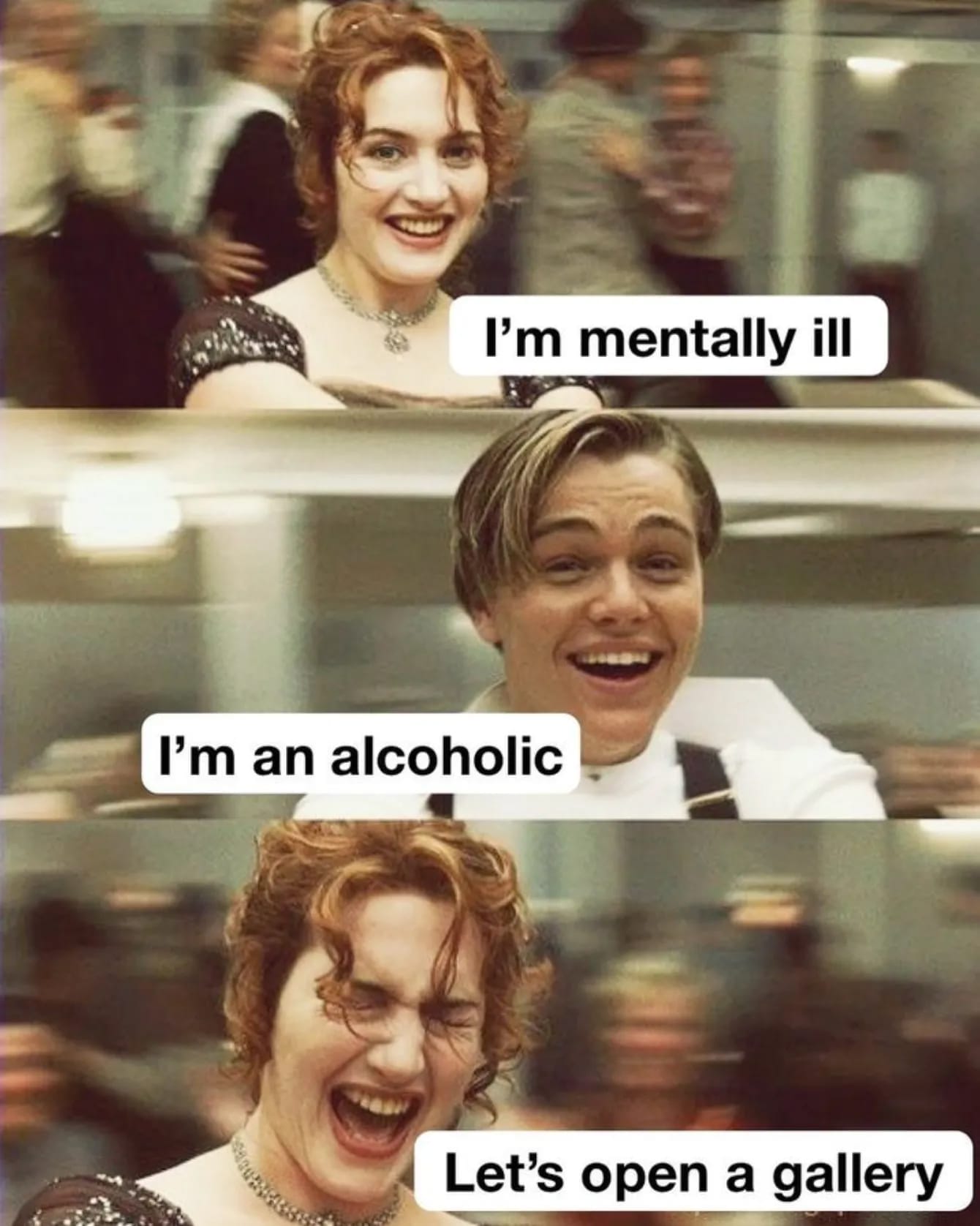
With a particular affinity for the digital and internet culture, both as a medium and semantically, artists like me, we could awkwardly labeled as “Internet natives 2.5” find ourselves inevitably in a position of rupture with traditional art history, its modes of production, distribution, and value exchange.

NFT ART < ART
Nevertheless , it has to be said that for an artist or people with a cultural and aesthetic training and heritage, interactions about art with web3 and NFTs people are often a bit disappointing..
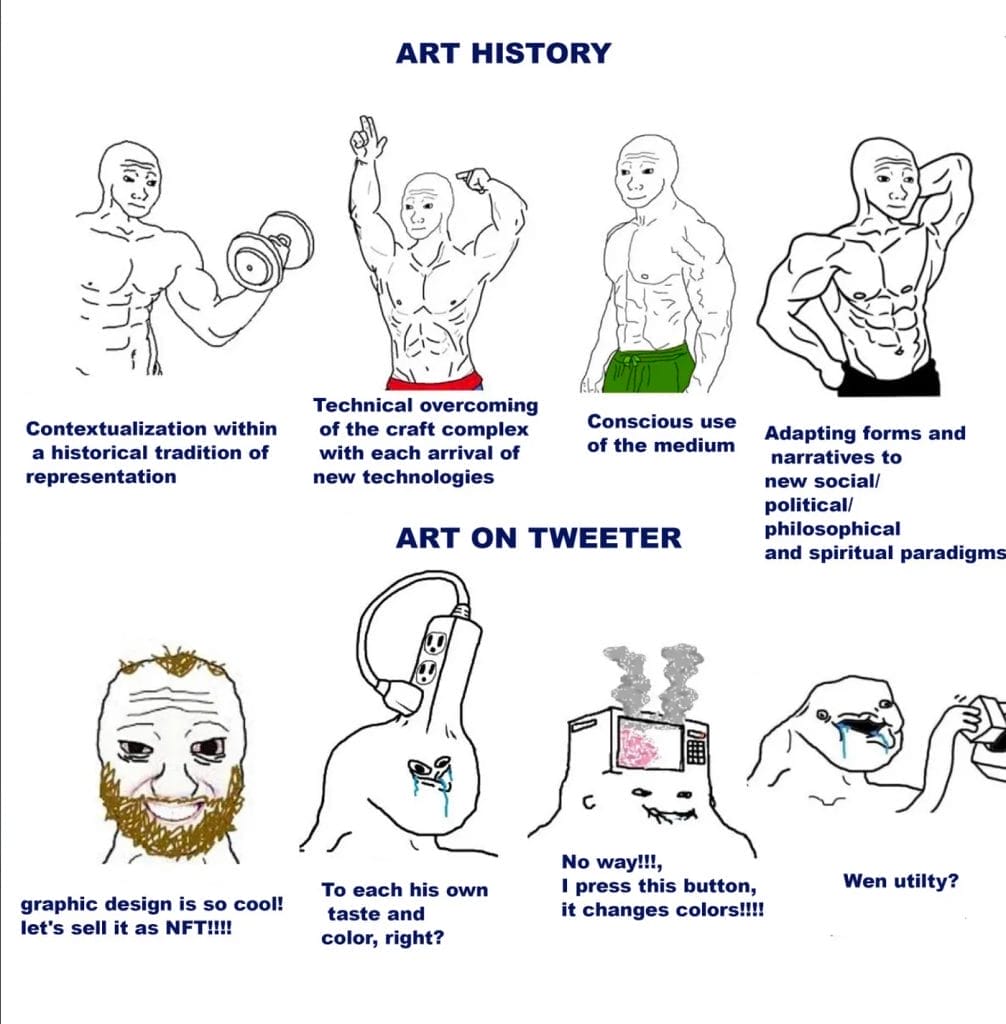
While the promise of decentralized and open-source data exchange over the Internet has never fully materialized, the advent of Web3 revives debates around the ideological foundations underlying these technologies.

Now, at a decisive moment where tools to harness new technologies such as AI and blockchain are widely accessible, the question arises: how to foster not just an “artistic movement” but a coherent collective dynamic identifiable in art history? Below are some reflections drawn from my experiences.
A (not) random exemple: The 3 Families of Le Fresnoy
During my studies at Le Fresnoy, National Studio of Contemporary Arts, (a unique European laboratory bringing together artists, scientists, and technologists), distinct “families” of artists were discernible.
(I’m talking about Le Fresnoy because a lot of internationally renowned artists in the art and “digital new media” scene who have passed through the Fresnoy.)
Even within this seemingly homogeneous ecosystem of digital and tech-savvy artists, three distinct profiles emerged:
– artists from fine arts using digital as a subject or medium.
– filmmakers exploring the medium of moving images (documentary, or new narrations)
– and engineers/inventors/ researchers seeking to conceptualize/contextualize their experiments in the art field.
Despite a shared interest in the digital, each group spoke a different language, pursuing diverse aesthetic ambitions, and they probably would not have agreed to be lumped together in the same stream.
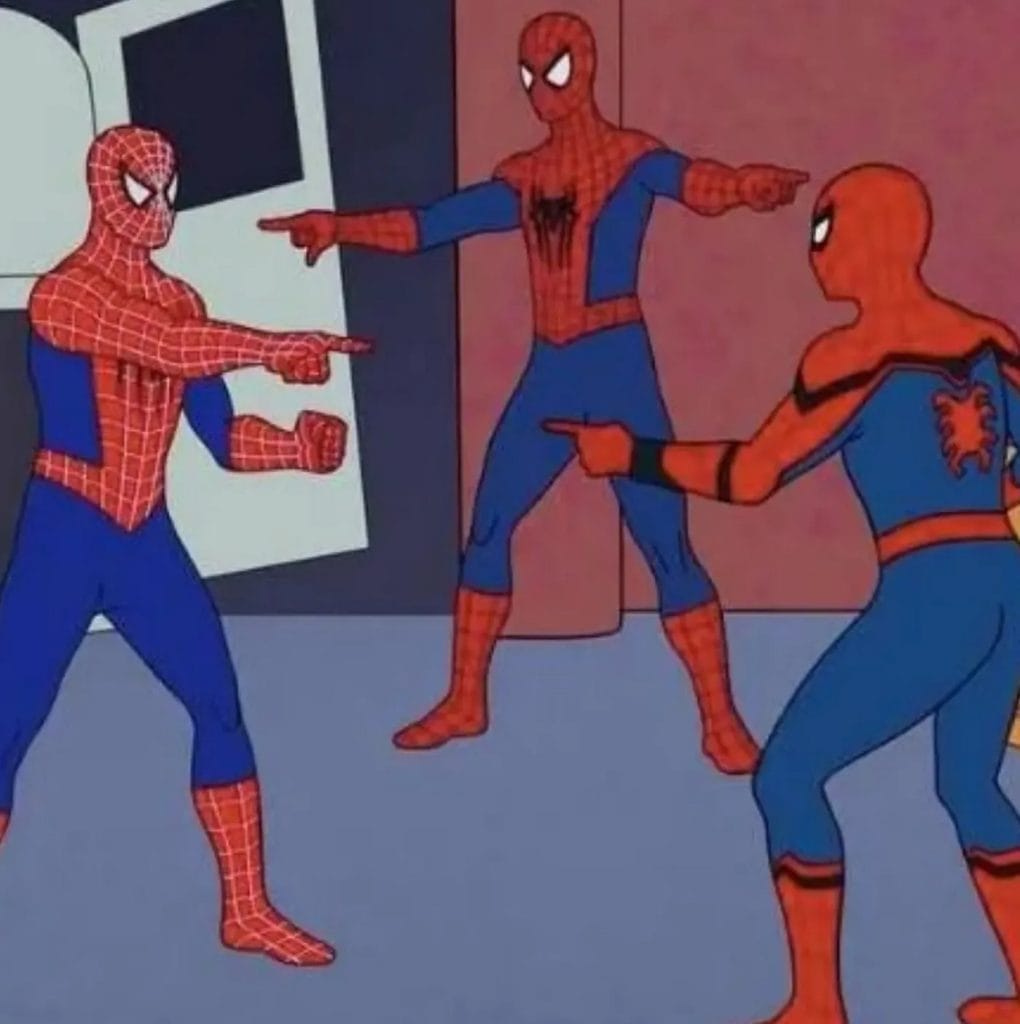
From Impression to Program
During a recent panel at PCA Stream on AI in the creative process i did with the art critic Nicolas Bourriaud, a notable shift was highlighted. Bourriaud observed that art history, traditionally marked by works resulting from a physical impression (a track in matter) , is now witnessing the emergence of art born more from a program than an impression. Forms like generative art and scenario-based cinema result from prior writing and execution more or less independent of the artist.

Aesthetic Shift of the Century in Digital Art?
An interesting observation is that, with the advent of photography, significant art movements manifested well after the appearance of the medium. Has the medium fracture already occurred with works resulting from programs? Probably not, but it is imminent. The emergence of technologies such as artificial intelligence and blockchain induces true transformations through the democratization of tools. It is likely that this shift will occur in existing media, such as cinema or video art, present on the scene for a long time. However, it is probably now that the most emblematic forms will emerge from internets and digital arts.

Let’s talk about money
Beyond aesthetics, one of the promises of “web3″ is to change the traditional ways in which the art world operates. Mainly on questions of production, distribution and trade of artworks.

Object Economy and Project Economy
From outsiders, Economic dynamics in the traditional artistic domain are often overlooked. Despite misconceptions about the profitability of contemporary art, especially for living artists, fragile economic models surround contemporary creation. Exhibitions are often free, escaping industrial logic (like cinema or video games) and many players are trying to capture the attention of very few collectors. No retails.
Although there are a few very wealthy players, the vast majority of others are often in a difficult position. Art world is an environment where wealth inequalities are even more violent than in traditional finance. Withholding information is a way for everyone to pretend they’re in good health, when no one is fooled. Web 3 will fix it?
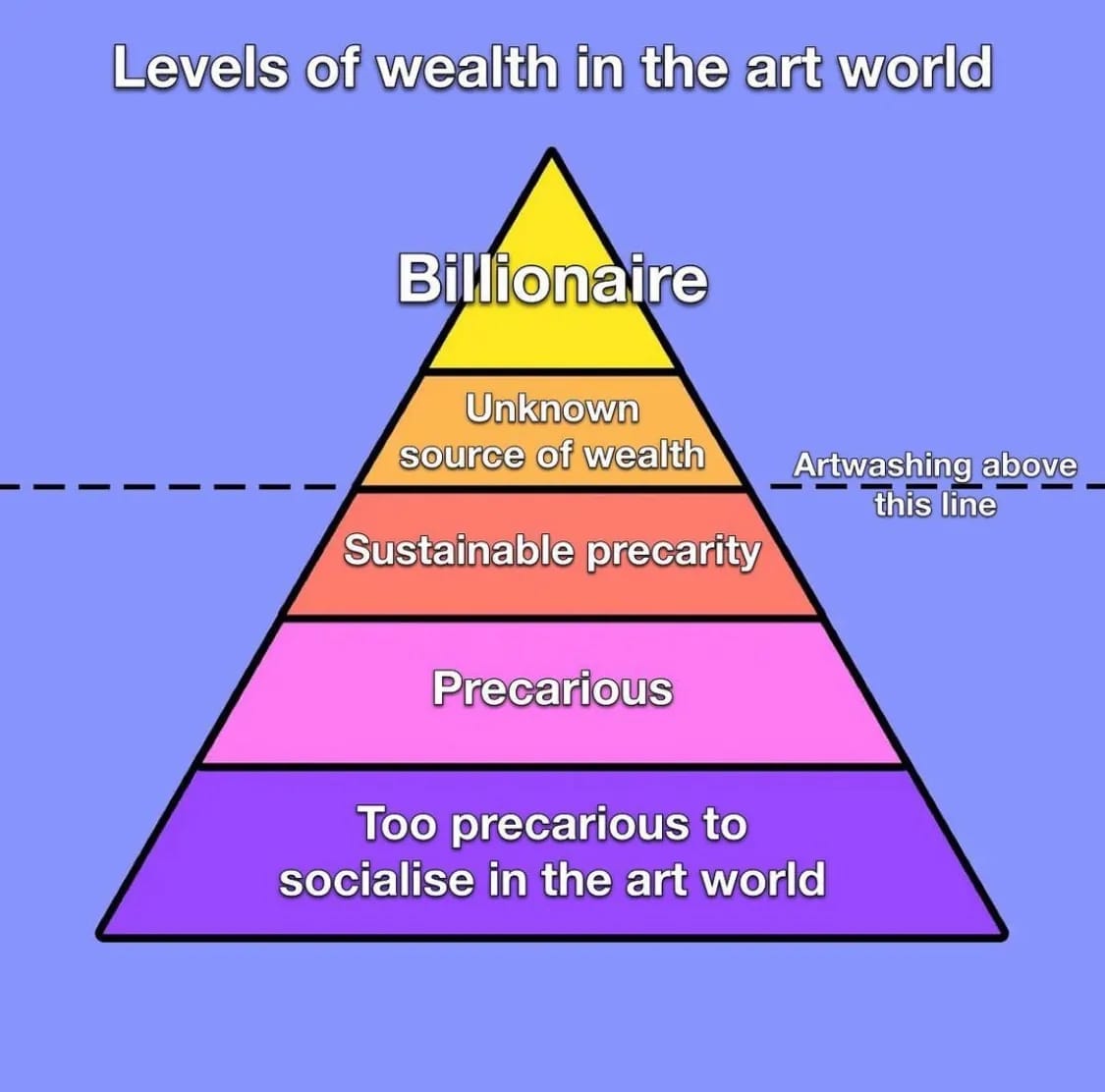
The economic model can be divided into two distinct parts, each taking various forms:
– patronage (public or private)
– and a speculative system based on a Ponzi pyramid.

In parallel, two types of creation can be identified from an economic perspective:
– project economies (cinema, happening , video art, land art etc..)
– and object economies (paintings, sculptures, objects).
Before the advent of blockchain and the promise of digital scarcity, some projects classified in project economies migrated to an object economy. Consequently, some projects conditioned by patronage take on a speculative dimension.
This could be a real game changer for the new digital mediums which, as this graph shows, are in the blind spot of this already struggling market.

Web3: Art, Technology, and Cultural Industry
From an artistic point of view, I observe several “movements” that stand out. I will describe them, offering a volontary critical and satirical perspectives, providing insights into why these different groups struggle to communicate.
Contemporary Artists: Using the internet and technologies in their work, often prioritizing the concept over technology, which may not be genuinely operative. There is often a background of techno-critique, a narrative that often finds favor with art decision-makers, reacting against the “tech gurus” of Silicon Valley.
Digital Artists: Considered by some as true pioneers of their medium. However, the term “digital art” often carries a dated connotation, as if it were a movement fascinated by innovation, where art attempts to create didactic and anecdotal curiosities, somewhat lagging behind the latest technological advances compared with start-up products (VR, AR)
Graphic Designers: Often coming from socials media like “Reddit or Tumblr culture”, followed by large communities, some are now considered the “blue-chip” NFT artists. They sometimes struggle to contextualize their work in art history, often proposing aesthetic forms and questions that were resolved a hundred years ago.

On the other hand, there is an ever-evolving internet culture, oscillating between mass phenomena such as streaming and video games, as well as micro-niches (like archeologists, Rare Pepe, counter party, BTC ordinals, or artists using blockchain as a medium) with underground forums, specific references, and codes. Often these groups are not permeable to each other. When taking a step back, it is challenging to position oneself clearly as an artist in this constantly changing landscape.
Of course, These three categories are not exhaustive, for example I really like this tweet by the artist FAR , which highlights two distinct groups in the web3 space:
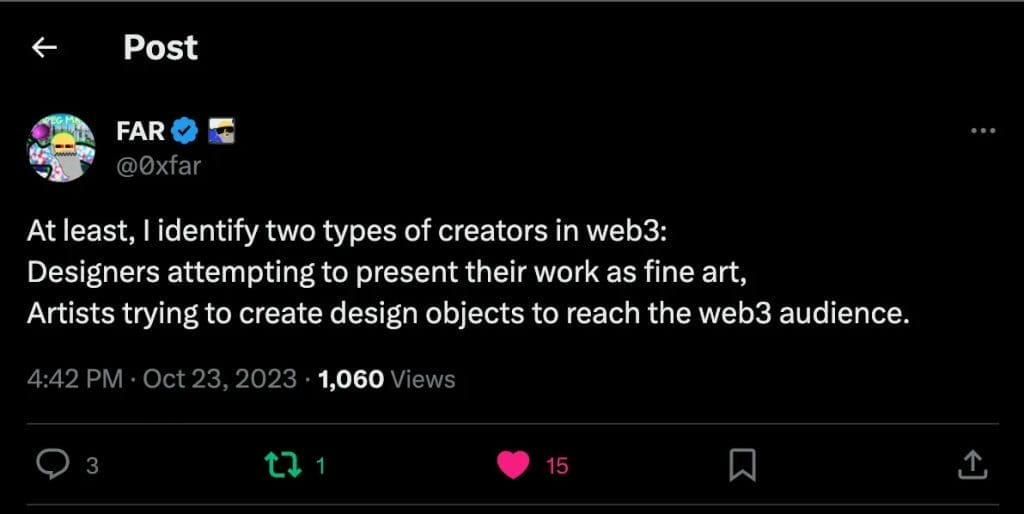
Confronting the Difficulty of Unity, Are Digital Contemporary Artists Condemned to Remain Lone Wolves?
Since the 20th century, it seems that art history has only recognized artists who have associated in groups. Others would call it movements. This corroborates the doctrine: “Together, we move more slowly, but we go further.” These movements are characterized by artists sharing common interests, intuitions, and desires. Feeble attempts have been made in the last 30 years to bring together identifiable individuals around common practices and visions. None has resulted in a significant movement.
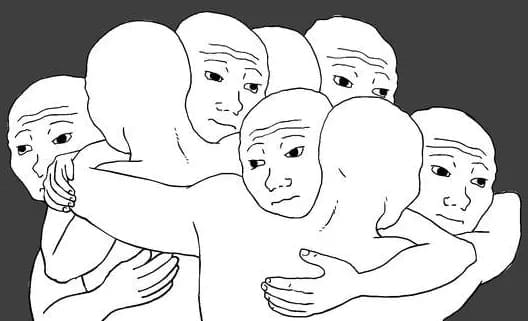
The Glitch Residency: Potential for an Artistic Movement in the Making?
I have just returned from a strange but somewhat cool time in a castle. A momentum created by Primavera De Filippi bringing together developers, engineers, artists, thinkers, and poets. I wasted a lot of time in recent years meeting “the wrong people”, but there were no casting errors here. Each person I spoke to led to a conversation of more than an hour that could have continued for an entire day, cut short only by the need not to miss the opportunity to meet someone else in the room.

Among the actors in the decentralized world, many tend to seek validation from institutions. Here, it was an “extitution.” No guidelines, no hierarchy. Just a sum of skills left to themselves. Where the momentum could have been sterile, many seeds have been planted in the arid soil of unification.
Between a gathering that would connect different individuals through common energies (like a religion, ‘religere’ being its etymology), and a university without a program where everyone is both a teacher and a student, it’s challenging to define.
Perhaps an interesting way to talk about it could be that this experience was “not not a cult”.
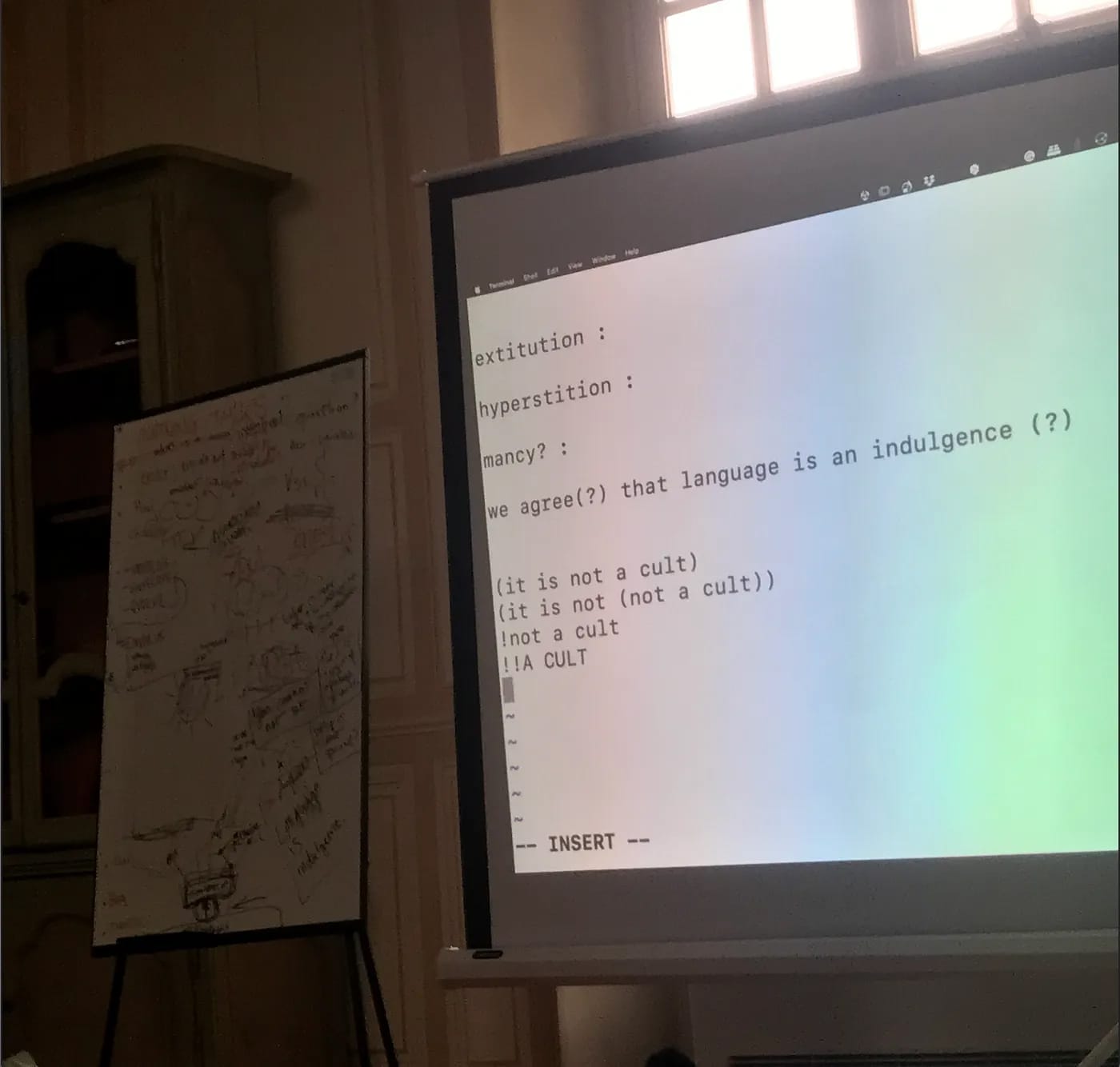
I have the intuition that the solution could lies in a gesture in line with the initial ideology of the internet. I recently met Sylvain Levy, a visionary traditional art and digital art collector, we were talking about that and he gave me the idea of “open source” in art.
Now my question is:
“How to create in Art a dynamic that would be to contemporary creation what open source is on the internet?”
All this text has no other vocation than to testify to my present enthusiasm and to invite people to contradict or complete my remarks, and above all to open up the debate on this subject.
My intuition is that a dynamic égregore could be born, acting like an aesthetic tidal wave in the contemporary art landscape.
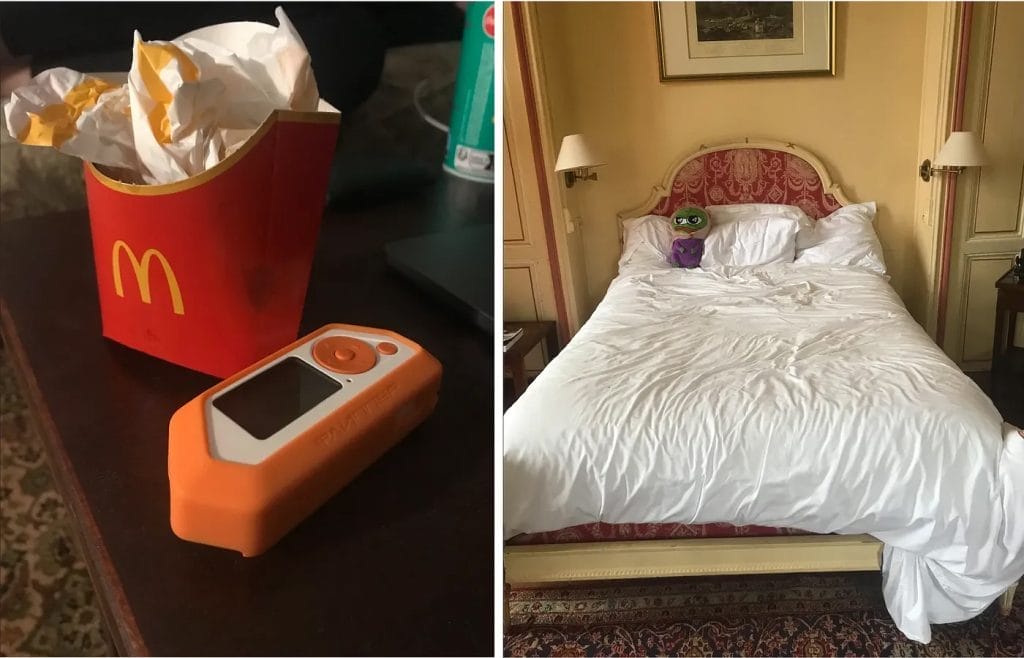
Conclusion
The issue
For the moment, decentralization in art didn’t work. The only incentives for DAOs are financial. And the people who talk about art in this ecosytem are also talking about finance with a backdrop of technology narrative.
Open source
For a long time I’ve been thinking about a solution that would be a protocol. What bitcoin is to currency, create the same thing for art. A network without an identified founder and owner. Subject to both consensus and discord, with no conflict of interest or murky political-economic agenda.
In art more than anywhere else, it’s time to use technology, not as a marketing tool to raise funds, but as something that solves problems.
AI Gurus, and blockchain Archives
I don’t want to delve into all the possibilities here, but it seems to me that AI and blockchain will play a role. AI in data collection/distribution and blockchain in decentralized archiving. The complete decentralization of aesthetic impulses often results in something lukewarm. If aesthetic breakthroughs were achieved collectively, they would also be led by “gurus,” charismatic personalities. In the individualistic age we live in (from which artists do not escape), it would be meaningful to establish as a leader on this path an entity that would have assimilated everyone’s ideas and could present them without ego, in a curated manner.
A kind of peer-to-peer aesthetic decentralized information, production, distribution, and redistribution system.
To be continued.
Pierre Pauze
Pierre Pauze is an Artist & filmmaker. A graduate of Le Fresnoy and the Beaux-Arts de Paris, Pierre Pauze has won the Artagon prize, the Agnes B prize, the ADAGP revelation digital art video prize, and recently the Hauts-de-Seine department prize at the Salon de Montrouge. Currently resident at Poush, he was previously resident at the European program the Spur and at the Cité internationale des arts in Paris. His work has been shown in numerous exhibitions in France and around the world, such as at the Centre Pompidou Paris, Monnaie de Paris, FIAC, La Villette, the Es Baluard Museum in Palma, Mallorca, the K Museum of Contemporary Art in Seoul and the "Futures of Love" exhibition at the Magasins généraux. Pierre Pauze's films have been shown in festivals and on television, in France and abroad. He realized the film and installation project Mass in duo with the artist June Balthazard, which has been shown in several biennials including the 12th Taipei Biennale, the Beijing Digital Art Biennale and the Chengdu Biennale in China. The work was recently presented at Luma Arles during the Luma days and at the Centre Pompidou in Metz. Pierre PAUZE also invests the web3 territory through the creation of a decentralized production & diffusion protocols on the blockchain.
You may also like
Living Machines: Geumhyung Jeong’s Dance of Humanity and Technology at ICA
Entering Geumhyung Jeong’s Under Construction at the ICA in London is an experience that provo
Anti-Crash by Scerbo: A Verse Release Curated by Fakewhale
Scerbo is set to unveil the “Anti-Crash” series on Verse curated by Fakewhale — A series, in w
Fakewhale in Dialogue with Mathias Pöschl
Mathias Pöschl’s work transforms mechanical processes and simple materials into two-dimension

